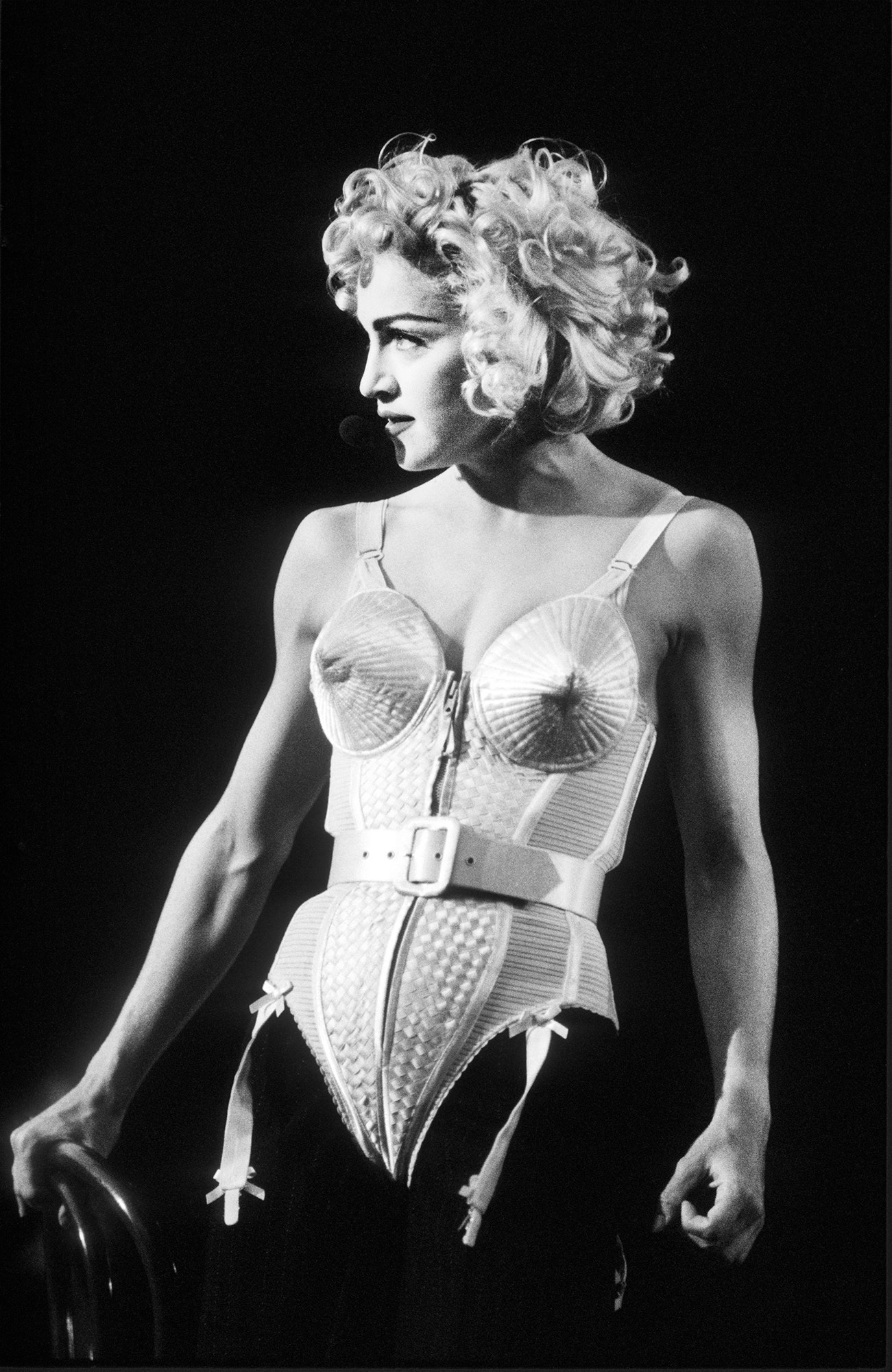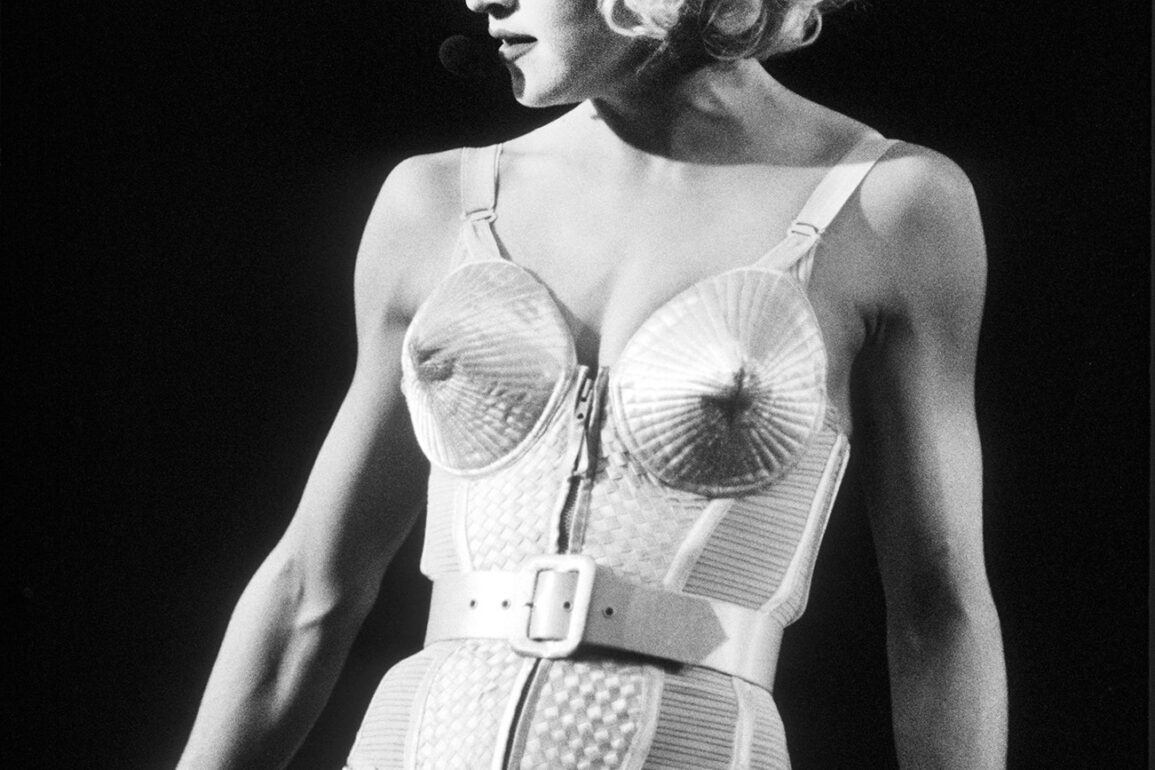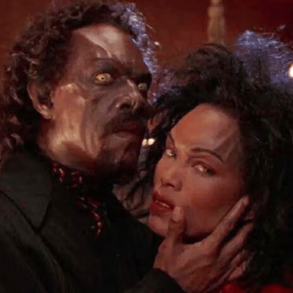
Madonna’s divorce from Sean Penn was finalized on January 25, 1989, the same day Pepsi announced an unprecedented agreement with her. She would release her new single, “Like a Prayer,” during a Pepsi commercial in exchange for $5 million and Pepsi’s sponsorship of her next tour. The ad marked the first time a record would premiere in a commercial and the first time a TV commercial would be given a global launch. Pepsi said it would be seen in forty countries — or “just about every TV set on the planet Earth”— with an estimated viewership of 250 million people. Madonna’s manager Freddy DeMann called the marketing campaign around the record and the commercial the “pop-world equivalent” of a new Star Wars film.
By 1989, commercials and advertisements featuring celebrities and their work had become cultural events. Andy Warhol and Keith Haring illustrated ads for Absolut Vodka. Spike Lee created an ad starring Michael Jordan for Nike. Miles Davis and Lou Reed appeared separately in Honda scooter commercials. But no industry relied more on famous boosters than the one peddling soft drinks. In a country where, per capita, people drank more soda pop than they did water, celebrities were needed to build brand loyalty, especially in the teenage market, which grew in value by billions of dollars each year. Pepsi and Coca-Cola were engaged in a hot and high-profile “cola war” that pitted their beverages and their ad budgets against each other. And that necessitated attracting more and bigger stars.
Since 1984, Pepsi had featured entertainers in its ads — Michael Jackson, Tina Turner, David Bowie, Lionel Richie, and the Miami Sound Machine. It had even considered Madonna in 1985, but a scandal erupted after Playboy and Penthouse published nude photos of a young Madonna, and she was deemed too controversial. By late 1988, controversy (apparently) be damned, Pepsi considered her a must-have. Rival Coca-Cola had signed George Michael for a Diet Coke commercial directed by Stephen Frears. Pepsi’s retort was the Madonna deal.
Releasing her new song during a commercial was risky on many levels, not least because it bypassed the crucial radio market. “At first I thought, is it really Madonna doing this?” Warner’s Tom Ruffino told Q magazine. “But I’ve never met an artist who was so in tune with her own career; she plots it out very carefully. I realized that this would be an enormous way to achieve immediate recognition for the record from millions of people.”
In an interview with Rolling Stone, Madonna defended the decision, saying, “As far as I’m concerned, making a video is also a commercial . . . [and] record companies just don’t have the money to finance that kind of publicity.” Besides, she said, she liked the idea of fusing art and commerce, which made the former more “accessible” and elevated the latter.
The Pepsi spot would be directed by Joe Pytka. He was perhaps best known in the late ’80s for an unforgettable public service ad he created for a campaign called This Is Your Brain on Drugs. It involved an egg, a frying pan, and a terrifying sizzle. The Madonna job came his way after he shot Michael Jackson’s video for “The Way You Make Me Feel” and a Jackson commercial for Pepsi. But Madonna wasn’t sure she wanted to work with Pytka, at least not until he brought choreographer Vincent Paterson onto the project.
In a documentary called, “Vincent Paterson—The Man Behind the Throne,” Pytka said that Madonna told him she would not sing or dance in the Pepsi ad.
The contract didn’t call for that, but I wanted Vince to work with the other performers in the piece just to give it some energy. And she walked onto the set while he was rehearsing the other dancers. And she came over to me and asked me to introduce her to Vincent and the next thing I know, she’s in there dancing.
That introduction was, for Madonna’s career, the most important part of the commercial. Paterson would go on to choreograph some of her iconic performances, from her “Vogue” and “Express Yourself” videos to her Blond Ambition tour to parts of the film Evita.
Madonna and Vincent Paterson were compatible in part because of their backgrounds. Paterson, too, was raised in a conservative household steeped in Catholicism, which he credited with introducing him to the notion of theatricality. Though white, he grew up in Philadelphia in a mixed-race neighborhood where he learned to dance on the street. And, like Madonna, he became a little parent after his father left Vincent’s mother and eight children.
They were also sympathetic artistically. Paterson’s first love was theater. As a result, his dancers performed as characters who expressed themselves through movement. And finally, Paterson drew inspiration from the same well as Madonna — old films, fashion, photography — and he thrived on collaboration. “She is the first person I’ve ever synthesized so completely with as an artist,” he told writer Matthew Rettenmund.
The story recounted in the Pepsi commercial is a clever mix of past and present: a woman haunted by her past and a child dreaming of her future. The segment begins with black-and-white home-movie-style footage of Madonna as a child (played by eight-year-old Heidi Marshall) over which Madonna’s voice sings the opening phrases of “Like a Prayer.”
On-screen, the past then becomes present, with the young Madonna gobsmacked, watching mature Madonna on TV, cool as hell dancing in the street, in a diner, and inside a club. Mature Madonna also dances with children in a Catholic school and in a crowded church, where a congregation and choir raise her song to the heavens. Pytka ends the spot with the adult Madonna holding a Pepsi can and the young Madonna holding a vintage Pepsi bottle as the older says to the younger, “Go ahead, make a wish.” It is Madonna telling her younger self to be brave.
Though Madonna was the star, Paterson embedded her in the crowds she danced with so thoroughly that the commercial feels like a generous celebration of them all. He told U magazine he took his cue from Madonna in that regard.
I’ve worked with a lot of people in this business. She has the best grip on success that I ever [encountered]. I first noticed it, actually, when we were doing this Pepsi commercial. We shot a scene in a Catholic school in a hallway. It was Madonna amidst, maybe, twenty schoolgirls that were from seven to thirteen years old. And, instead of going out to the trailer to hang, there was a little break, and she said, “Hey can you open up one of these classrooms?” They opened up a classroom and she took all the girls in there for a half hour and they all just sat and talked.
The commercial was beautiful and inspiring. Pepsi executives were so excited that they prepurchased $10 million worth of airtime. But there was a problem they were not aware of. Madonna had shot a separate video for “Like a Prayer” that would appear on MTV. It, too, was beautiful and inspiring, but it was also more controversial than anything Madonna had ever done at that point. If the Pepsi ad marked a commercial milestone, the video for the song marked a cultural one.
The previous December, Madonna met director Mary Lambert for dinner and asked her to shoot the video for “Like a Prayer.” Since 1986, when they had last worked together — on “La Isla Bonita,” from True Blue — Mary had largely stepped away from video to concentrate on films. She spent much of 1988 in Maine directing an adaptation of Stephen King’s Pet Sematary. Horror wasn’t her first choice; doing a movie with a female protagonist was, but in the late ’80s, that kind of film was a hard sell. It seemed the only place a woman could tell a woman’s story was in video, through a woman’s song.
Mary agreed to rekindle her creative partnership with Madonna. “By that time we were really solid friends and we really trusted each other,” Lambert told Jen Yamato in the Los Angeles Times. After dinner, “we got in whatever . . . Mercedes she was driving at the time and just drove around Hollywood. We drove up to Mulholland and we listened to [‘Like a Prayer’] . . . pumped up on her car stereo.”
The video they made for “La Isla Bonita” three years earlier involved three sets, five hundred extras, and a four-day shoot in downtown LA. In it, a virtuous Madonna is shown in her room longing to be part of the vibrant street life. It was like the story lines they had done so well before. “Like a Prayer” would be different.
It would also involve a choice, although this time the choice would be about right and wrong. It was also about religious and sexual ecstasy and the idea that there was no need to choose between them, because a person could relinquish herself to both. And it was about patriarchy and the choice a woman must make to either submit to or to defy it. “That was all part of the dialogue,” Mary continued. “We wanted to take certain things that are a given or a convention and say, why couldn’t it be this? . . . I knew there was going to be some controversy, but I wasn’t prepared for how much.”
The song “Like a Prayer” could have been filmed in many ways, but Madonna wanted to give it the look and feel of LA’s literary and cinematic noir tradition and use religious imagery to tackle racism and bigotry. Racial tensions at the time were headline news.
That April in South Central, the LAPD’s already aggressive antidrug program graduated to a military-style scorched-earth campaign that did not discriminate between crack dealers and civilians in making arrests, gunning down “suspects,” or reducing homes to ruins. In New York, meanwhile, there were so many cases of police brutality against Black people that Harlem minister Reverend Lawrence Lucas called the city the “most polarized” and “racist” in America.
Other artists besides Madonna had also begun to tackle race in their work. In the summer of ’88 Spike Lee was in Bedford-Stuyvesant shooting his first political film, Do the Right Thing, about a neighborhood that finally exploded under the burden of racism. Madonna’s “Like a Prayer” and Lee’s Do the Right Thing would both pose troubling questions. They also focused on an individual’s responsibility to confront racism wherever he or she finds it.
To help tell the story, each used music: Madonna chose her own, while Lee picked Public Enemy’s “Fight the Power.” At the time, Public Enemy was called the “world’s most dangerous band.” “I think those guys in Public Enemy are heroes,” Madonna told Glenn O’Brien in Interview. “They’re not afraid to say things.” She thought Spike Lee was a hero, too. That was what was in the air as Madonna worked on “Like a Prayer.”
Her video told a simple tale of a moral awakening through a spiritual one. Madonna plays a woman who sees a gang of white men assault a white woman. Hiding and afraid to get involved, she watches as a Black man comes to the woman’s assistance. For his troubles, he is arrested by police and charged with the crime. Having taken shelter in a church, Madonna prays to a statue of a Black saint who looks like the Good Samaritan she just saw being arrested. She thinks she sees the saint crying.
“She lies down on a pew and falls into a dream in which she begins to tumble in space with no one to break her fall,” Madonna said in a 1989 interview with The New York Times. She is caught by a strong woman who sends her back to the clouds and tells her to do what she knows is right. Madonna’s character is still dreaming when her religious and erotic feelings merge and the statue of the saint becomes a man. At that moment, Madonna slices her hands with a knife. “That’s the guilt in Catholicism that if you do something that feels good, you will be punished,” she explained.
The song of a choir washes over Madonna as religious ecstasy merges with sexual ecstasy. Madonna awakens knowing she has the strength to do what is right — to speak about what she saw and free the innocent man. The entire cast takes a bow, Madonna said, because the story isn’t just one character’s, it is everyone’s. Everyone has a role in ensuring that good and love triumph over evil and hatred. That was Madonna’s scandalous message.
It was the video’s imagery that proved so shocking, including Madonna dancing in a slip in front of burning crosses. “I grew up in Arkansas, at a time when there was a lot of racial tension and violence, [which] was really offensive to me,” Mary said in the oral history I Want My MTV. “One of the reasons I used a burning cross in ‘Like a Prayer’ was to force people to deal with the image I grew up with.” And then there was the image of Madonna humbling herself by kissing the feet of the statue and the saint returning her kiss when he comes to life in her dream. Though they rarely said so, critics’ hostility was inflamed by the fact that the saint was Black. Said Mary Lambert in Rolling Stone several years after the video’s release:
Interracial unions are still controversial in this country, especially within the broad demographic of MTV and national television. In “Like a Prayer,” it’s not just Madonna having an affair with a black man. The religious imagery makes it much deeper than that.
Veteran music writer Greil Marcus, appearing in a 1990 documentary called Madonna—Behind the American Dream, called the video “blasphemy on about ten levels at once, which as a story is as upsetting a piece of public work [as] you’re going to see anywhere . . . You have interracial sex, you have sex between a human being — a woman played by Madonna in the video — and a saint, a black saint, who may not be a saint at all; he may be Jesus. That’s just for starters.”
Madonna’s embrace of Black culture and her sounding off on racial issues weren’t just controversial for whites. Important Black figures such as the feminist bell hooks criticized Madonna for what she called the appropriation and commodification of Black culture. She said that Madonna’s use of Black people in the video was exploitative, that the woman who caught Madonna as she fell through the air was a “modern mammy,” and that the choir was like the “singing black slaves in the great plantation movies.” But hooks conceded that she was speaking from the perspective of an older generation and that young Black women were “diehard” Madonna fans.
To those younger women, Madonna was an inspiration. In a collection of essays called Madonna and Me, author Joshunda Sanders said that in the video for “Like a Prayer,” Madonna had
power and clout to spare, and she chose to subvert the idea that blackness was something white women should stay as far away from as possible . . . She was down without trying to be. She was a sister in white-girl skin . . . She kept my attention because of her interactions with people of color in her videos and concerts . . . Madonna was the first non-black artist of my generation to really place herself in the center of blackness and black art without mocking it or trying to supplant it. She even moved a little like a sister . . .
As a white artist who was unafraid to express her affinity for black culture in a time before it was cool, Madonna set the stage for a new generation of women — celebrities and regular folks alike — to express themselves outside of racial classifications.
Religion was the other point of controversy in the video, and yet Madonna’s interest in it was real and profound. “My Catholic upbringing is probably the foundation of everything I do right now,” she said at the time. She was a staunch critic of the church, but her criticism was from inside the family, spoken as a Catholic. Madonna said she prayed “constantly . . . I pray when I’m in trouble or when I’m happy.”
The church was where Madonna believed she experienced her first feelings of sexuality and eroticism. And it was the place where she was first exposed to art. All those personal elements came together in her video. She even looked like herself. The brunette who appeared on-screen was the woman Madonna Ciccone, not the star Madonna.
Excerpted from the book MADONNA: A REBEL LIFE by Mary Gabriel. Copyright © 2023 by Mary Gabriel. Reprinted with permission of Little, Brown and Company, a division of Hachette Book Group, Inc. New York, NY. All rights reserved.
More Great Stories From Vanity Fair
This post was originally published on this site be sure to check out more of their content.









